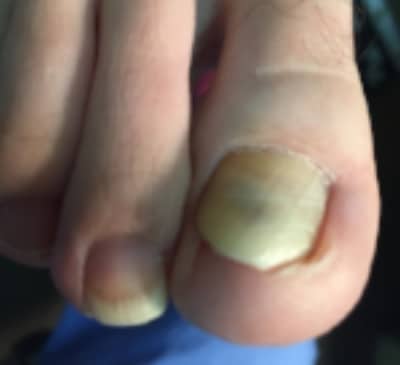
My ingrown toenails keep coming back. The main causes of ingrown toenails?
Some people can go their whole life without ever suffering from ingrown toenails. So why to some people get them and others don’t? Some common causes and risk factors are:
- Ill-fitting shoes or high heels: Tight shoes and high heels can cause the toes to be compressed together too tightly. The pressure can cause the nail to grow abnormally. Shoes that are too loose can can cause rubbing and irritation. The resulting inflammation can start the process of an ingrown toenail.
- Improper trimming of toenails: If cut incorrectly, toenails can be more prone to becoming ingrown. Nail should not be cut below the tip of the toe and trimmed straight across, not rounded. Incorrect trimming techniques can cause the corners of the toenail to cut into the skin.
- Genetics: Some underlying physical factors can be passed down through the family. The shape of the nail and the bone under the nail can be the result of heredity. If someone in your family has had an ingrown toenail then you are more likely to get one as well.
When should I seek help for an ingrown toenail?
An ingrown toenail begins when a corner of the toenail cuts into the skin as it grows. An infection can occur at that site because the ingrown toenail breaks the skin barrier. Signs of an infection are soreness, redness and swelling. If allowed to progress, pus and/or blood will drain from the site. Since it can lead to some very serious repercussions, an infected ingrown toenail should not be ignored. It can lead to a serious infection of the deep tissue, a bone infection, or an infection on the blood. The National Institutes Of Health advise that those with poor circulation, nerve damage, AIDS, or diabetes to seek medical treatment right away.
You must treat your ingrown toenail with the help of a doctor, when you visit them they will recommend you the following treatments:
1. Lifting The Nail
If your ingrown nail is mild then your doctor may need to lift it a little.
They will gently lift your nail edge and place a small cotton ball below it so that the nail stops growing inside the skin and starts growing above the surface.
This process can take at least 12 weeks and your doctor will recommend you change the cotton ball every day to avoid infection.
2. Partially Removing Your Nail Through a Small Surgery
If your case is serious, lifting the nail doesn’t work or you develop this nail problem repeatedly then removing the problem causing part of your nail can be a good option.
This requires a small surgery. First, your doctor will numb the area with local anesthesia and then remove the ingrown part of your nail.
This surgery won’t take long but the nail may take time to regrow.
Later on, your doctor will dress up the toe to protect it from infections.
Home Remedies For Ingrown Nail
Home remedies are really effective if your case is mild but if you have problems like diabetes or any circulatory problem then you should avoid them and get medical treatments right away!
Here are some of the best home remedies for ingrown nails:
1. Apple Cider Vinegar
Apple cider vinegar is an effective method to deal with ingrown nails since it has anti-inflammatory, anti-bacterial, and pain-relieving abilities.
You can soak your affected foot in a mixture of water and apple cider vinegar for at least 20 minutes every day!
2. Antibiotic Ointment
Antibiotic ointment or cream purchased over-the-counter can aid in healing and reduce the risk of infection.
Apply the ointment to the infected toenail as directed by the manufacturer, usually three times each day.
How does toenail shape influence the likelihood of ingrown toenails?
Toenail shape can significantly influence the likelihood of ingrown toenails. The way toenails grow and their curvature can impact how they interact with the surrounding skin and whether they are more prone to becoming ingrown. Here are key factors to consider:
- Curvature: A toenail that curves excessively, especially on the sides, is more likely to grow into the surrounding skin. This curvature can create a natural channel for the nail to dig into the flesh, leading to ingrown toenails.
- Width: Wider toenails may increase the chances of the nail edges pressing into the adjacent skin. This is particularly true if the toenail is too wide for the nail bed, causing the edges to dig into the surrounding flesh.
- Improper Cutting: Incorrect nail-cutting techniques, such as rounding the edges or cutting them too short, can contribute to ingrown toenails. This is because sharp or curved edges may have a higher tendency to pierce the skin.
- Genetics: The natural shape and growth pattern of toenails can be influenced by genetics. Individuals with a family history of ingrown toenails may be more predisposed to the condition.
How should individuals care for their feet to reduce the risk of ingrown toenails?
To reduce the risk of ingrown toenails, individuals can adopt proper foot care practices. Here are some recommendations:
- Trim Nails Correctly:
– Cut toenails straight across without rounding the corners. This helps prevent the edges from growing into the surrounding skin.
– Use clean, sharp nail scissors or clippers, and avoid cutting the nails too short.
- Avoid Tight Footwear:
– Choose shoes that provide enough room for toes to move comfortably. Tight or narrow shoes can compress the toes, increasing the risk of ingrown toenails.
- Select Appropriate Footwear:
– Opt for shoes with a wide toe box to accommodate the natural shape of the toes.

